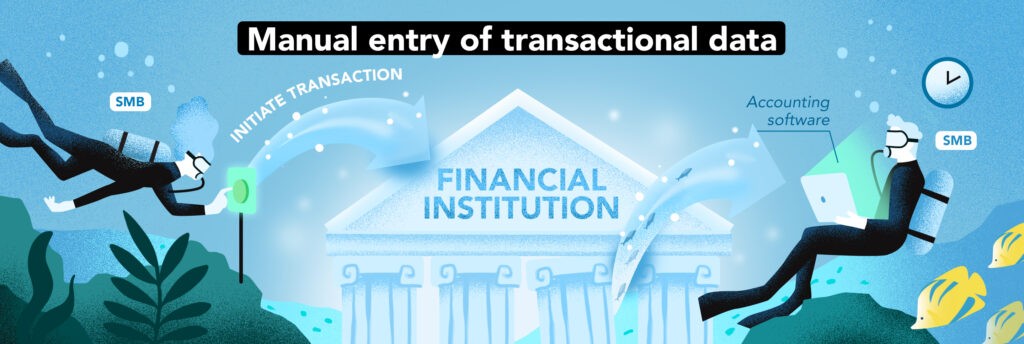
Flinks gives you the power to build the future of finance. Connect, enrich and utilize financial data to delight your customers with amazing products.
The Benefits of Open Banking for Commercial Banking – a Deep Dive
The digitization of the global economy is significantly transforming the financial landscape in Canada. Its greatest impact can be seen in the expectations of Canadians, who are now demanding more efficient, secure, and accessible financial services. It’s also reshaping how businesses operate in an increasingly interconnected world, pushing them to integrate digital solutions into their operations to stay competitive and meet the evolving needs of their customers.
There has also been concurrent growth of homegrown financial technology services and products with Canadian business needs in mind. Open Banking is one of the beneficiaries of this growth, as more businesses are discovering the power of seamless and personalized financial experiences. However, a recent survey by the Financial Consumer Agency of Canada, found that Canadians have an incomplete understanding of Open Banking.
Open Banking in Canada is often thought of as a regulatory requirement, where financial institutions (FIs) will need to provide secure ways to share data for the customers through API gateways. The truth of the matter is that FIs that offer Open Banking provide far more benefits to Canadian businesses that go beyond satisfying regulations.
In order to stay competitive and relevant, FIs need to modernize the banking experience for their customers. This is particularly true for commercial banks, as they make their products and services easier and more accessible so that their clients are able to securely engage in business transactions without the limitations of traditional brick and mortar banking. The secure data sharing elements of Open Banking are one of the features that can be leveraged, but there is much more that Open Banking can bring to commercial banking, which this article will explore.
Building an ecosystem of financial services
Canadian small and medium-sized businesses (SMBs) are increasingly adopting financial tools and services to drive growth, streamline operations and increase security. In fact, 95% of SMBs have used a new financial tool in the last two years!
This development opens up a world of possibilities for FIs. It’s an opportunity to cultivate meaningful partnerships with other financial service providers and create a suite of products and services that go beyond banking. By collaborating to provide services specifically tailored for SMBs, FIs can deliver extraordinary value, transform the way businesses handle their finances, and support SMBs with the right tools to support them as they look to grow.
Accounting platforms

Over 78% of SMBs use an accounting platform to manage their financial operations. Many SMBs rely on manual entries to conduct reconciliations and bookkeeping, which can take up to a quarter of a person’s work week! This limits efficiency and takes away time that can be better spent on other initiatives that would benefit the business, such as strategic planning, improving customer service, or the faster development of innovative products and services.

Open Banking, through a secure data sharing API, allows for the real-time sync of transactional data between the bank and accounting platforms, which in turn automates the accounting process. This automation reduces the time spent manually collecting and inputting data, decreases the chances of human error, while also increasing the accuracy of the information being collected.
By establishing a partnership and data sharing connection with accounting platforms, banks will be able to provide services beyond day-to-day banking, giving them an advantage over competitors that do not offer digital banking or the same level of convenience.
Cross Border Payments

Approximately 60% of SMBs rely on fintech solutions to manage sending and receiving payments. They also rely on fintechs to facilitate simplified cross-border payments, a complicated process that can limit a business’s ability to grow.
Cross-border payment usage by SMBs is also increasing, 2021 alone saw a 38% increase. This growth isn’t much of a surprise as businesses look outwards to both grow and recruit international talent.
Although there is an increase, 75% of SMBs are dissatisfied with the cross-border payment solutions due to poor processing times that limit their cash flow capabilities, as it can take several days for the payment to be settled.
With Open Banking, via data sharing API, real-time data of the bank account and balance can be shared to expedite the settlement process. This means cross-border payments can be verified and made available almost instantly from a bank account.
This also allows FIs to provide a more competitive service in terms of cost. That’s because Open Banking enables real-time foreign exchange rate access for SMB clients and reduces the impact of cost fluctuations. This is a major advantage for SMBs looking to reduce their overhead costs while they continue to do business with cross-border clients.
Open Banking allows for the automation of many manual administrative processes, reducing the cost of manual intervention. As with accounting reconciliations, this streamlined process allows for more efficient operations, faster service delivery, and improved customer experiences. Being able to quickly send and receive payments is always a net benefit.
Businesses are looking to work with FIs that make it easy to manage their finances, offer seamless cross-border transactions, provide real-time data insights, and deliver personalized customer service. When FIs form partnerships and establish data-sharing connections to enable cross-border payment solutions, it enhances their daily banking services. This strategic move also gives them a competitive edge in the commercial banking market.
Key Takeaways
These are some of the many use cases that demonstrate how FI’s can enhance their commercial banking offerings, making convenience and speed key advantages. Loans, for example, are another use case for FIs, where they can immediately assess the creditworthiness of a business applicant. By utilizing data-driven risk assessments, FIs can gain the insights needed to establish suitable interest rates, terms, and conditions. With the business already a client of the FI, the ability to quickly provide those funds to the business also keeps them within the FIs ecosystem as there is no need for them to look elsewhere.
Open Banking at the core is an opportunity to leverage real-time data-sharing capabilities to advance the banking experience, making it faster and more convenient for businesses to do their work. Creating an API marketplace also gives FIs the ability to seamlessly integrate a variety of third-party financial services that complement their own offerings, all within a single platform.
Although the costs and resources needed to establish partnerships and build direct connections may be challenging at first, the long-term benefits of working with partners with an existing network to connect from are significant. These benefits include streamlined operations, enhanced customer service, and the potential for increased revenue and market share.
If you’re interested in learning more about implementing an Open Banking or financial data sharing program, check out our whitepaper, where you’ll find case studies showing how other FIs have implemented their own successful Open Banking solutions.
Ready to put financial data to use for commercial banking? We’ve got the Open Banking expertise to help you get there.

You might also like

This article dives into the most relevant Open Banking use cases for FIs, including product flow examples and tips for successful Open Banking implementation.

Industry experts from National Bank of Canada, EQ Bank, and Flinks share insights on Open Banking in Canada, including key considerations for successfully implementing a Canadian Open Banking framework.